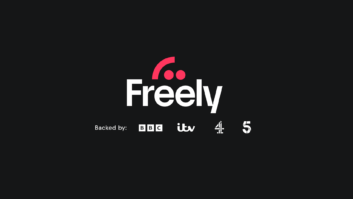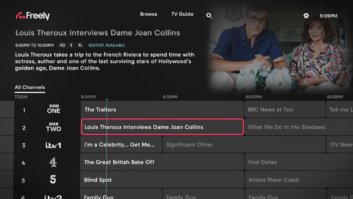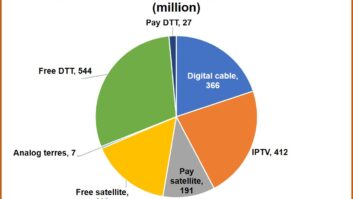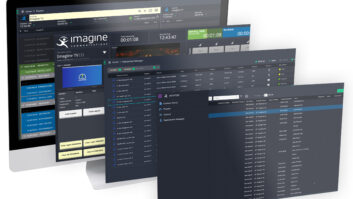This article makes the case that the UK’s precious free-to-air TV platform landscape is under threat. Unless it is free to innovate, we will lose a whole sector to Amazon, Google and the other global software giants. It makes the case that the broadcaster shareholders in the free TV platforms are focusing too much time and effort on their own BVoD apps while limiting innovation at platform level. A platform wide collaboration would deliver much better outcomes for viewers, and enable a strong market response to the global tech giants’ encroachment on the UK television market..
The UK’S ‘subscription-free’ TV platforms – Freeview, Freesat and (the retail version of) YouView make up half the UK TV landscape by household. They are rightly heralded as one of the key successes of the UK’s TV digitisation programme. They gave UK viewers free access to the other fruits of this digital revolution – the new ‘digital’ channels from the public sector broadcasters (PSBs) and a wide range of new broadcasters, in the face of an explosion in pay-TV boxes and services.
Free TV platforms were conceived at a time when there was little idea of ‘functionality’ around TV content. The first boxes were simple affairs that just delivered ‘more’ broadcast TV as well as incredibly simple on-screen guides. The assumption was that people would keep their existing TVs and just plug in one of the new set top boxes to enjoy digital TV.
Since that time there have been a number of significant shifts and the market context for free TV has changed fundamentally. Firstly, the emergence of cheap flat screen TVs has driven waves of upgrades as people traded up to ever larger screens. Because these screens contain digital TV tuners, set top boxes, once the dominant device for accessing free TV, have become increasingly marginal.
One impact of this shift from boxes to screens has been the diminution of the free TV brands. When the market was box-centric, brands like Freeview and Freesat were the dominant on-screen presence (albeit in a simple, flat menu structure). Now on smart TVs, among the complex app and functionality pages, the free TV brands barely appear. At best they have been relegated to the TV guide page. The rising brands are either screen manufacturers like Samsung or LG, or operating system companies like Android, Roku and Amazon.
Part of the challenge has been the shift in location of TV design and innovation. Previously, most set top boxes were designed in, and specified for, the UK market. Most TVs are now designed and manufactured in the far east, to meet a universal specification, with the minimal amount of ‘localisation’ for the UK market. The upside of this is that the UK consumer can get a 50” flat screen for £350. The downside is that they are manufactured by people with little interest in protecting cherished idiosyncrasies of the UK market like the prominence of the PSBs in any on-screen menu and presentation.
Another significant change has been in the pervasive spread of pay-TV. When Decipher first started researching TV there was a clear distinction between free-TV homes and pay-TV homes. During research people would proudly declare ‘we don’t pay for TV’ and show us their Freeview or Freesat boxes. Over time, it became clear that many of these people had started getting Netflix and other pay apps. Now, most ‘free’ TV screens come with all the pay SVoD apps, already loaded and prominent in the on-screen menus. Most of the UK’s PSB apps aren’t even loaded when TVs are shipped. Decipher research shows that 68 per cent of homes with a ‘free’ TV device as the main TV screen also have at least one pay SVoD account.
It has become apparent that UK television viewers are now happy to pay, log-in and exchange data in return for access to great content and functionality. Initially, this willingness was just exploited by the new SVoD apps like Netflix and Amazon. Now, there is a new generation of TV platforms doing the same as the media streamer companies move into full TV platform mode. The arrival of Amazon branded TV screens and TV boxes brings competition for the free TV platforms from companies fully equipped to capture log-in data, build profiles and use AI to deliver functionality and other benefits.
This revolution has passed the free platforms by as they are held back by their broadcaster shareholders from driving this kind of innovation. The broadcasters are prioritising innovation at app level, rather than at platform level. They are all individually trying to build data capture, recommendations, personalisation into in their individual apps, while denying the platforms the chance to build it at platform level.
There are two related problems with this strategy. Firstly, it doesn’t work. Speak to any media agency and they will tell you that broadcaster app data is viewed as limited and unreliable. Broadcaster apps just don’t have the content volumes or viewing time to build up anything like useful data required by the ad market. Once a log-in is set up, the broadcaster apps have only limited ability to build data or maintain its accuracy. This problem is compounded by the fact that broadcasters can’t measure or attribute use of their core product – their broadcast channels – on any of the free TV platforms.
Secondly, this strategy leaves the free TV platforms fighting a competitive battle against companies like Amazon and Google, with one arm tied behind their back. The launch of Amazon branded TV screens should have set alarm bells ringing in all the shareholder board rooms. The response to this has to be at platform level.
This failure to organise is most keenly felt in the advertising industry who are looking to the television platforms to create a data-rich environment for TV advertising that can support greater addressability and targeting. Outside of Sky and Virgin, no UK TV platform is able to capture the kind of information required for addressability or to deliver data-enriched advertising. Do you think an Amazon TV will fail to do that on their newly launched TV platforms?
If the free TV platforms are allowed to build log-ins, account profiles, and capture data required for future advertising models, they would also be able to offer new generations of functionality like personalised recommendations, network PVR, and mobile device integration. These functions are increasingly viewed as ‘hygiene factor’ functionality in the TV industry. More importantly, they could build a free TV version of Sky’s AdSmart platform, that would deliver addressable ad capability into the 50 per cent of the UK market where it is currently impossible.
The UK’s free TV platforms have the skills and capability required to build the new wave of TV services required to compete against Amazon and Google. Moreover they have trusted brands that have great salience among key segments of the UK audience. They need to be allowed to build platform level data and services infrastructure. If we want the free platforms to have relevance in the emerging TV landscape we have to set them free to innovate.







